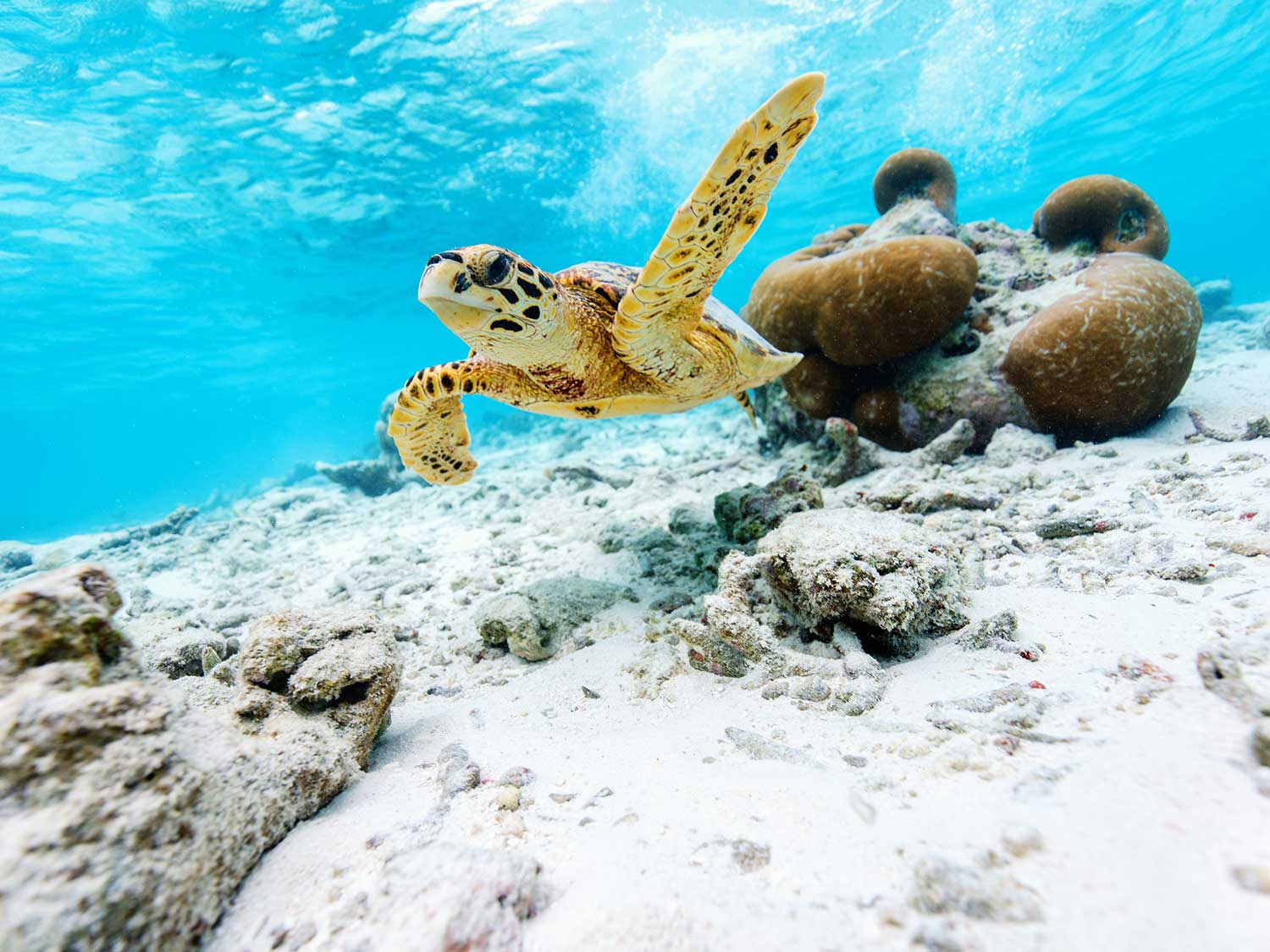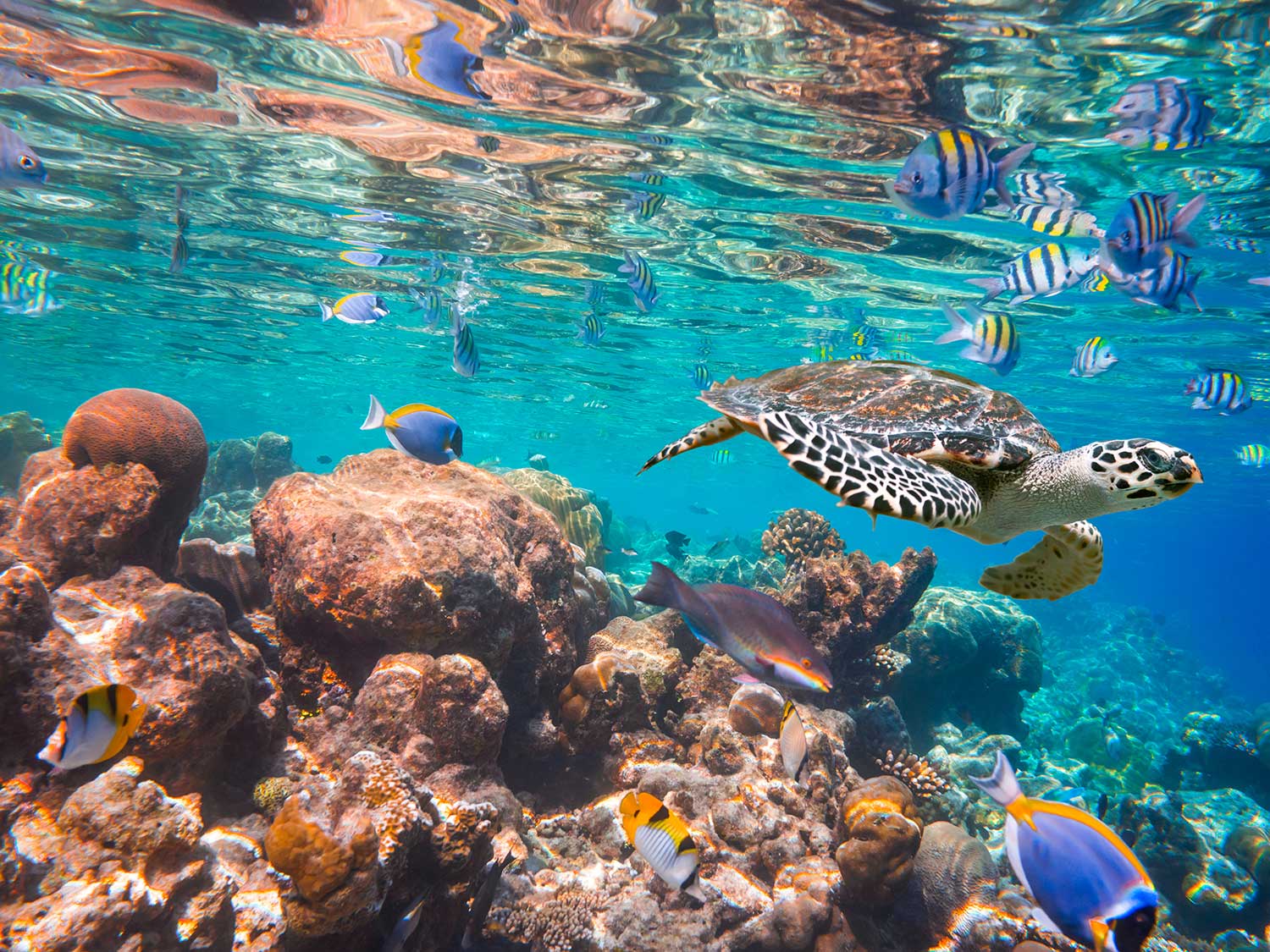Swimming With Turtles In The Middle Of The Indian Ocean
Joali Resort in the Maldives delivers one of the most sure-thing adventures by putting guests up close with marine wildlife.
The kids are excited. The dhoni has just pulled up to the welcome center of Joali Resort, one of the poshest resorts in the Maldives. Two families and I are loading up to snorkel what is hailed as one of the best spots locally for sea turtles. Specifically, hawksbills, identifiable by their pointy beak and jagged shell.
In my few days at one of the resort's overwater bungalows, I've already seen a spotted eagle ray, a southern stingray cruising in tandem with two blue jacks, and about a dozen blacktip reef sharks. Go pretty much anywhere in this island nation in the middle of the Indian Ocean, some 600 miles from Sri Lanka, and you'll be surrounded by sea life—even more so at the more remote isles, such as Muravandhoo Island, home to Joali Resort.
But for turtles, we're told Gemanafaru Island, 20 minutes away by boat, is the spot.
The water is flat and so clear when we arrive that one of the dads asks if it's okay to jump in from the boat. He's worried about hitting the reef below but doesn't realize how deceiving the clear water is, making the reef appear close—and yet it is actually 40-feet down.
With that, we splash in. Immediately, we see a juvenile turtle at the surface, breathing before diving down again. The kids squeal.
Pretty Little Things
As they duck-dive to get closer views of the turtle, it pushes up toward me. I am the only snorkeler not moving. I've been scuba diving for 26 years and have learned a thing or two about turtles. For one, treat them like models. The more you ignore them, and even look away, the less threatened they feel, which makes them curious why you don't find them intriguing. Typically, if you ignore a turtle, it very likely will swim up to you and even follow you.
Just as I'm playing games with this one, our guide, Ahmed Aafaag, excursion diver with Best Dives, beckons us to head in his direction.
I'm torn, though. I think of the days when I lived in Brooklyn and attended many house parties; I learned that it's rarely a good idea to leave a house party where you already have a good scene going.
I've got good action happening now, but the tour has just started. I follow Aafaag.
Coming to Blows
Aafaag's got the eye. It seems that as soon as he's pointing out one turtle and I start to observe it, he's pointing to another. I follow one turtle for a few minutes as it leads me past a lobster and several giant clams. At one point, we watch as a day octopus, fully out of its den, parachutes between rock piles and curls up around the corals.
Then I see something I have never seen before.
I'm keeping pace with a juvenile, just ambling along. It drops down, presumably to start snacking on algae. No sooner does it descend a bit than a bigger hawksbill, nearly twice its size, darts toward the smaller one. It lunges its head forward, snapping. The two spin in a circle, beaks nearly touching. The bigger one doesn't relent until the smaller starts flapping its fins wildly, waving a white flag in this territorial battle.
I've seen turtles mating before, but never turtle aggression. Most sea turtles tend to be solitary, preferring to hunt and sleep alone. On most reefs, it's likely that the real-estate-to-turtle ratio is such that there's room to spread out, and thus be peaceable. Here, the reef is packed with turtles—moving at a slow pace, we see 11 in 40 minutes. Perhaps because so many favor this one spot, competition becomes a given.
Turtles for Progress
The competition could very well be a good thing. A sign that local populations are on the rise—great news indeed, considering that hawksbills are the among the most endangered sea turtles, with worldwide numbers hovering around 40,000.
Sea turtles are marine species that are easy to get excited about, and for good reason. They're typically slow moving, allowing snorkelers good opportunities to view their behavior. Although speedy when scared, they often appear slow and clumsy on the reef, moving one front fin at a time and occasionally bumping their shells into coral boulders as they negotiate tight spaces.
Oh, and they hide like 5-year-olds: Just as children will have their feet poking out from under the curtain, and a turtle will bury its head in a small cave, with its rump fully exposed.
Perhaps that's why we love them. And perhaps that's why they're such a great species for helping introduce children and ocean newbies to the joys of the reef. For very little effort, one gets a front-row seat to a fascinating animal—one that is wholly aware of our presence and often displays legendary curiosity.
In a way, they're a gateway animal, one that hooks someone's attention quite readily, transforming him into a lifelong advocate for the ocean and every living thing that calls it home.


